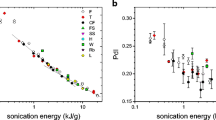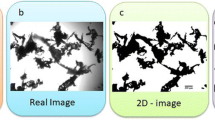Abstract
We investigate the use of dispersive surface energy in quantifying surface amorphous content, and the concept of effective amorphous surface area is introduced. An equation is introduced employing the linear combination of surface area normalized square root dispersive surface energy terms. This equation is effective in generating calibration curves when crystalline and amorphous references are used. Inverse gas chromatography is used to generate dispersive surface energy values. Two systems are investigated, and in both cases surface energy data collected for physical mixture samples comprised of amorphous and crystalline references fits the predicted response with good accuracy. Surface amorphous content of processed lactose samples is quantified using the calibration curve, and interpreted within the context of effective amorphous surface area. Data for bulk amorphous content is also utilized to generate a thorough picture of how disorder is distributed throughout the particle. An approach to quantifying surface amorphous content using dispersive surface energy is presented. Quantification is achieved by equating results to an effective amorphous surface area based on reference crystalline, and amorphous materials.



Similar content being viewed by others
REFERENCES
Buckton G, Dove J, Davies P. Isothermal microcalorimetry and inverse phase gas chromatography to study small changes in powder surface properties. Int J Pharm. 1999;193:13–9.
Buckton G, Ambarkhane A, Pincott K. The use of inverse gas chromatography to study the glass transition temperature of a powder surface. Pharm Res. 2004;9:1554–7.
Adamska K, Voelkel A. Inverse gas chromatographic determination of solubility parameters of excipients. Int J Pharm. 2005;304:11–7.
Adamska K, Voelkel A, Heberger H. Selection of solubility parameters for characterization of pharmaceutical excipients. J Chromatogr A. 2007;1171:90–7.
Newell H, Buckton G, Butler D, Thielmann F, Williams D. The use of inverse phase gas chromatography to study the change in surface energy of amorphous lactose as a function of relative humidity and the process of collapse and crystallization. Int J Pharm. 2001;217:45–56.
Planinsek O, Buckton G. Invergas chromatography: considerations about appropriate use for amorphous and crystalline powders. J Pharm Sci. 2003;92:1286–94.
Newell H, Buckton G. Inverse gas chromatography: investigating whether the techniques preferentially probes high energuy sites for mixtures crystalline and amorphous lactose. Pharm Res. 2004;8:1440–4.
Adamson A, Gast AP. Physical chemistry of surfaces. 6th ed. New York: Wiley; 1997.
Sun C, Berg J. The effective surface energy of heterogeneous solids measured by inverse gas chromatography at infinite dilution. J Colloid Interface Sci. 2003;260:443–8.
van Oss C, Good R. Surface tension and solubility of polymers and biopolymers: the role of polar and apolar interfacial free energies. Journal of Macromolecular. Science. Chemistry. 1989;26:1183–203.
Schultz J, Lavielle L. Inverse gas chromatograophy: characterization of polymers and other materials. In: Lloyd D, Ward T, Schreiber H, editors. ACS Symposium Series 391. Washington DC: American Chemical Soceity; 1989.
Hogan S, Buckton G. The quantification of small degrees of disorder in lactose using solution calorimetry. Int J Pharm. 2000;207:57–64.
Ho R, Wilson D, Heng J. Crystal habits and the variation in surface energy heterogeneity. Cryst Growth and Des. 2009;9:4907–11.
ACKNOWLEDGMENTS
The authors would like to thank Dr. Rachel Forcino, and Ms. Maria Barnett for supplying the samples of Drug Substance A, and amorphous lactose respectively. We also thank the reviewers for constructive comments.
Author information
Authors and Affiliations
Corresponding author
Rights and permissions
About this article
Cite this article
Brum, J., Burnett, D. Quantification of Surface Amorphous Content Using Dispersive Surface Energy: the Concept of Effective Amorphous Surface Area. AAPS PharmSciTech 12, 887–892 (2011). https://doi.org/10.1208/s12249-011-9655-5
Received:
Accepted:
Published:
Issue Date:
DOI: https://doi.org/10.1208/s12249-011-9655-5




